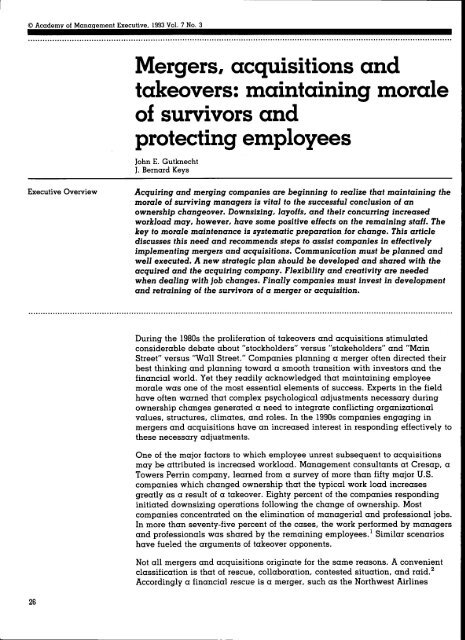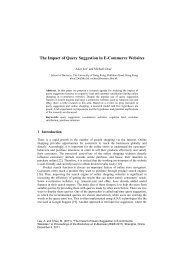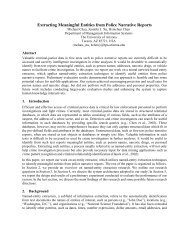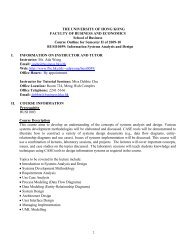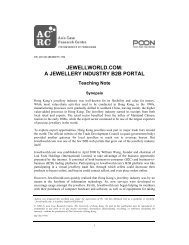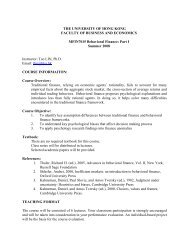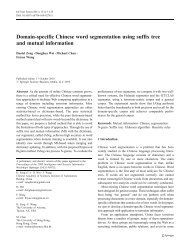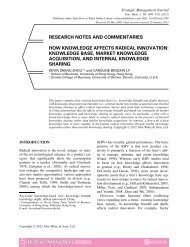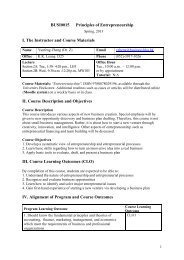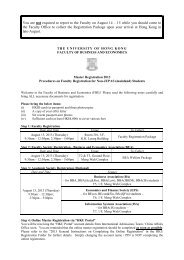Mergers, acquisitions and takeovers: maintaining morale of ...
Mergers, acquisitions and takeovers: maintaining morale of ...
Mergers, acquisitions and takeovers: maintaining morale of ...
Create successful ePaper yourself
Turn your PDF publications into a flip-book with our unique Google optimized e-Paper software.
Academy oi Management Executive, 1993 Vol. 7 No. 3<br />
<strong>Mergers</strong>, <strong>acquisitions</strong> <strong>and</strong><br />
<strong>takeovers</strong>: <strong>maintaining</strong> <strong>morale</strong><br />
<strong>of</strong> survivors <strong>and</strong><br />
protecting employees<br />
John E. Gutknecht<br />
J. Bernard Keys<br />
Executive Overview<br />
Acquiring <strong>and</strong> merging companies are beginning to realize that <strong>maintaining</strong> the<br />
<strong>morale</strong> <strong>of</strong> surviving managers is vital to the successful conclusion <strong>of</strong> an<br />
ownership changeover. Downsizing, lay<strong>of</strong>fs, <strong>and</strong> their concurring increased<br />
workload may, however, have some positive effects on the remaining staff. The<br />
key to <strong>morale</strong> maintenance is systematic preparation for change. This article<br />
discusses this need <strong>and</strong> recommends steps to assist companies in effectively<br />
implementing mergers <strong>and</strong> <strong>acquisitions</strong>. Communication must be planned <strong>and</strong><br />
well executed. A new strategic plan should be developed <strong>and</strong> shared with the<br />
acquired <strong>and</strong> the acquiring company. Flexibility <strong>and</strong> creativity are needed<br />
when dealing with job changes. Finally companies must invest in development<br />
<strong>and</strong> retraining <strong>of</strong> the survivors <strong>of</strong> a merger or acquisition.<br />
During the 1980s the proliferation <strong>of</strong> <strong>takeovers</strong> <strong>and</strong> <strong>acquisitions</strong> stimulated<br />
considerable debate about "stockholders" versus "stakeholders" <strong>and</strong> "Main<br />
Street" versus "Wall Street." Companies planning a merger <strong>of</strong>ten directed their<br />
best thinking <strong>and</strong> planning toward a smooth transition with investors <strong>and</strong> the<br />
financial world. Yet they readily acknowledged that <strong>maintaining</strong> employee<br />
<strong>morale</strong> was one <strong>of</strong> the most essential elements <strong>of</strong> success. Experts in the field<br />
have <strong>of</strong>ten warned that complex psychological adjustments necessary during<br />
ownership changes generated a need to integrate conflicting organizational<br />
values, structures, climates, <strong>and</strong> roles. In the 1990s companies engaging in<br />
mergers <strong>and</strong> <strong>acquisitions</strong> have an increased interest in responding effectively to<br />
these necessary adjustments.<br />
One <strong>of</strong> the major factors to which employee unrest subsequent to <strong>acquisitions</strong><br />
may be attributed is increased workload. Management consultants at Cresap, a<br />
Towers Perrin company, learned from a survey <strong>of</strong> more than fifty major U.S.<br />
companies which changed ownership that the typical work load increases<br />
greatly as a result <strong>of</strong> a takeover. Eighty percent <strong>of</strong> the companies responding<br />
initiated downsizing operations following the change <strong>of</strong> ownership. Most<br />
companies concentrated on the elimination <strong>of</strong> managerial <strong>and</strong> pr<strong>of</strong>essional jobs.<br />
In more than seventy-five percent <strong>of</strong> the cases, the work performed by managers<br />
<strong>and</strong> pr<strong>of</strong>essionals was shared by the remaining employees.^ Similar scenarios<br />
have fueled the arguments <strong>of</strong> takeover opponents.<br />
Not all mergers <strong>and</strong> <strong>acquisitions</strong> originate for the same reasons. A convenient<br />
classification is that <strong>of</strong> rescue, collaboration, contested situation, <strong>and</strong> raid.^<br />
Accordingly a financial rescue is a merger, such as the Northwest Airlines<br />
26
Gutknecht <strong>and</strong> Keys<br />
purchase <strong>of</strong> Republic Airlines, that includes an active <strong>and</strong> openly sought deal to<br />
bail a company out <strong>of</strong> difficulties. Company employees <strong>of</strong>ten feel a sense <strong>of</strong><br />
relief when the buyout is completed, but this feeling quickly dissipates if<br />
downsizing <strong>and</strong> strenuous cost cutting begin. Many mergers may be<br />
characterized by coiiaborafion in which one party wants to buy <strong>and</strong> the other<br />
party is willing to sell. Hewlett-Packard's purchase <strong>of</strong> Apollo Computer, Inc. to<br />
obtain first-place workstation market strength could be characterized as<br />
collaboration. A confessed mergei is one sought by only one <strong>of</strong> the two involved<br />
firms, thus making it difficult to obtain the cooperation <strong>of</strong> the acquired firm, as<br />
was the case with AT&T's takeover <strong>of</strong> NCR. During the takeover attempt, NCR<br />
Chairman <strong>and</strong> CEO, Charles Exley Jr., blasted AT&T for what he called threats<br />
<strong>and</strong> ultimatums which could "hardly be expected to create a feeling <strong>of</strong><br />
confidence in AT&T on the part <strong>of</strong> NCR people." A raid is a planned hostile<br />
takeover by a company, usually with little regard for the plans <strong>of</strong> the acquired<br />
company, such as Ichan's purchase <strong>of</strong> TWA.<br />
A major cause <strong>of</strong> negative feelings that ensue after a transition is the frequently<br />
resulting lay<strong>of</strong>f. Employees retained after a lay<strong>of</strong>f <strong>of</strong>ten experience feelings <strong>of</strong><br />
guilt, anger, <strong>and</strong>/or relief. Guilt, or perhaps anger, is generated when a<br />
co-worker is laid <strong>of</strong>f, <strong>and</strong> although the surviving employee may at first be<br />
pleased to have retained a position, the threat <strong>of</strong> future dismissals is usually<br />
present. Alternately, says Brockner, "survivors may feel pleased that the<br />
organization has finally rid itself <strong>of</strong> the deadwood."^ The possibility <strong>of</strong> peaceful<br />
<strong>and</strong> positive relationships with employees following a takeover grows slimmer<br />
as one moves from the rescue agreement to the stormy takeover <strong>of</strong> a raid. Ichan<br />
learned this costly lesson after grabbing control <strong>of</strong> rough-flying TWA Airlines. In<br />
fewer than three months following the changeover, 6,000 flight attendants<br />
walked <strong>of</strong>f the job. Next to leave were TWA's chief operating <strong>of</strong>ficer, general<br />
counsel, <strong>and</strong> most <strong>of</strong> the senior vice presidents. Federal Pension Benefit<br />
Guaranty Corporation is now threatening to charge Ichan with a $1.1 billion<br />
pension shortfall <strong>and</strong> to attach the debt to Ichan's non-airline businesses.^<br />
The possibility <strong>of</strong><br />
peaceful <strong>and</strong> positive<br />
relationships with<br />
employees following a<br />
takeover grows<br />
slimmer as one moves<br />
from the rescue<br />
agreement to the<br />
stormy takeover <strong>of</strong> a<br />
raid.<br />
From previous discussion, it can be observed that the origin <strong>of</strong> mergers <strong>and</strong><br />
<strong>acquisitions</strong> greatly influences their outcome. By examining the variety <strong>of</strong><br />
feelings generated, one is better able to respond to the question, "Can a<br />
corporate ownership change result in sustained or improved <strong>morale</strong> <strong>of</strong> its<br />
survivors"<br />
A Tale <strong>of</strong> Three Companies<br />
The authors examined, by means <strong>of</strong> a survey, the productivity <strong>and</strong> <strong>morale</strong><br />
changes resulting from three different corporate transitions. The survey was<br />
administered to the supervisors, middle managers, <strong>and</strong> administrators <strong>of</strong> three<br />
recently acquired companies. One <strong>of</strong> the sample firms was acquired by<br />
coiiaJborafion, another by a contested situation, <strong>and</strong> the third by a rescue<br />
operation.^ Two <strong>of</strong> the companies surveyed were manufacturing companies <strong>and</strong><br />
the third was a service-based company.<br />
Company A. This service company was acquired in 1990 by a larger operation<br />
which had been exp<strong>and</strong>ing through <strong>acquisitions</strong> <strong>of</strong> companies <strong>and</strong> the<br />
acquisition was a collaborative effort. Company A was a relatively small utility<br />
in the southeast with a closely held ownership. A progressive management had<br />
converted its generating plants from natural gas to coal, while retaining the<br />
flexibility to use natural gas when prices became attractive, but it possessed no<br />
nuclear facilities. The low cost <strong>of</strong> generated power made it a natural target for<br />
27
Academy <strong>of</strong> Management Executive<br />
an exp<strong>and</strong>ing company. The track record <strong>of</strong> the acquiring company was<br />
excellent, thus the marriage was attractive to both parties. It appears that<br />
administrative functions will gradually be assumed by the corporate entity <strong>and</strong><br />
that the company's distribution system <strong>and</strong> customer service facilities will<br />
remain autonomous.<br />
Company B. Company B, a multinational manufacturing company, was founded<br />
by one <strong>of</strong> the great American industrialists <strong>and</strong> once consisted <strong>of</strong> plants <strong>and</strong><br />
operations that spanned the globe. It had risen in the ranks to become a<br />
Fortune 500 company <strong>and</strong> earned sustained pr<strong>of</strong>itability in the 1960s <strong>and</strong> 1970s.<br />
The company then diversified into a number <strong>of</strong> businesses. But the loss <strong>of</strong> the<br />
advantages <strong>of</strong> favorable energy <strong>and</strong> raw material sources in the early 1980s<br />
resulted in a decline which ended in the splintering <strong>of</strong> the enterprise <strong>and</strong> the<br />
severance <strong>of</strong> the company's top management team. In this same period, when<br />
company pr<strong>of</strong>itability turned sour, the company attempted to resolve cash flow<br />
problems by selectively selling <strong>of</strong>f assets. Takeover attempts began in the late<br />
1980s. After a lengthy takeover battle the company ownership shifted into what<br />
could be defined as a contested situation. The acquiring company implemented a<br />
downsizing operation, resulting in a return to pr<strong>of</strong>itability. The remaining<br />
personnel consist <strong>of</strong> long-term employees who have experienced the company's<br />
fall from power.<br />
Company C. Company C is a high-tech aerospace manufacturer which was<br />
privately held by the CEO until the mid 1980s. It was acquired by a Forfune 100<br />
company attempting concentric diversification. When the parent company<br />
developed cash flow problems in 1990, it put Company C back "on the block."<br />
Following several failed divestiture attempts, the original owner was able to<br />
establish a consortium to repurchase the company under a highly leveraged<br />
buyout, thus representing a rescue-type acquisition. In the Company C<br />
acquisition, attention to "people concerns" was minimal. Little information was<br />
communicated about takeover details to the employees. Employee uncertainty<br />
about their future mounted <strong>and</strong> the work climate became threatening <strong>and</strong><br />
stressful.<br />
Survey Description <strong>and</strong> Basic Findings<br />
From the companies surveyed, approximately 400 people divided almost equally<br />
across the companies responded. The thrust <strong>of</strong> the survey was to determine<br />
perceived changes in <strong>morale</strong> in the face <strong>of</strong> perceived changes in workload, job<br />
satisfaction, opportunities for advancement, company productivity, <strong>and</strong><br />
retention <strong>of</strong> job security.<br />
In Companies A <strong>and</strong> B more than fifty percent <strong>of</strong> the responding persons<br />
believed that company productivity had increased. But in Company C<br />
significantly fewer employees believed that productivity had increased, <strong>and</strong> a<br />
much greater number <strong>of</strong> people believed that productivity had actually<br />
decreased since the buyout. Most respondents who reported improvements in<br />
productivity from all three companies also reported an increase in job<br />
satisfaction. In other words, it was found that the perceived change in<br />
productivity for respondents in the three companies was correlated with their<br />
perceived improvement in job responsibilities.<br />
Job Redesign as an Expianation <strong>of</strong> Survey Results<br />
It appears that improved job satisfaction <strong>and</strong> company performance<br />
demonstrated by these surveys can be attributed to fortuitous job redesign<br />
28
Gutknecht <strong>and</strong> Keys<br />
changes. In many cases the excessive layers <strong>of</strong> management, turf protection,<br />
<strong>and</strong> jurisdictional disputes that had developed over the years prevented job<br />
satisfaction. The "bulldozing" <strong>of</strong> department lines <strong>and</strong> downsizing which<br />
occurred with an accompanying removal <strong>of</strong> layers <strong>of</strong> management produced an<br />
improvement in job content for many respondents. Employees in Companies A<br />
<strong>and</strong> B believe they are better utilized <strong>and</strong> more effective since the ownership<br />
change.<br />
Preparation for Change as an Explanation <strong>of</strong> Survey Results<br />
The company that acquired Company A was very experienced in <strong>acquisitions</strong><br />
<strong>and</strong> perhaps for this reason gave greater attention to people concerns during<br />
the change than did Companies B <strong>and</strong> C. The method <strong>of</strong> communicating the<br />
Company A acquisition was more carefully planned than in the other two<br />
companies <strong>and</strong> it was publicized well in advance <strong>of</strong> the change. Monitoring<br />
employee attitudes began early <strong>and</strong> has continued.<br />
Company B had been unpr<strong>of</strong>itable for a number <strong>of</strong> years <strong>and</strong> the struggling<br />
company sold assets to remain liquid. Moreover, the acquisition became a<br />
hostile takeover that was resisted for a number <strong>of</strong> months, generating extensive<br />
publicity. Therefore, Company B employees could easily see the impending<br />
change <strong>and</strong> prepare for it.<br />
In Company C, the ownership change surfaced quickly <strong>and</strong> was accompanied<br />
by a great deal <strong>of</strong> uncertainty. A number <strong>of</strong> potential suitors were interested in<br />
the company <strong>and</strong> the confidential nature <strong>of</strong> such bids m<strong>and</strong>ated that employees<br />
be kept in the dark. Rumors about potential owners were rampant. Even when a<br />
former owner <strong>of</strong> the company regained control through a successful bid,<br />
information about the ownership change was not effectively communicated to<br />
employees.<br />
A majority <strong>of</strong> respondents from Companies A <strong>and</strong> B indicated that they heard<br />
about their buyout through formal company channels—their boss or a company<br />
announcement. Conversely most Company C employees reported that they<br />
heard through a co-worker (the company grapevine) or from some source outside<br />
the company. A significantly higher number <strong>of</strong> Company C employees felt that<br />
the company withheld information <strong>and</strong> misled them.<br />
It is difficult to discern perfectly the causes for the varying perceptions <strong>of</strong><br />
respondents to this survey. As noted, the reasons for the <strong>acquisitions</strong> were<br />
different, <strong>and</strong> the manner <strong>of</strong> implementation <strong>of</strong> each acquisition was different.<br />
However it appears that the significant attitudinal differences on the survey for<br />
Company C employees may be partially explained by the differences in<br />
preparation for ownership change in the three companies. One thing does seem<br />
certain. Morale in Companies A <strong>and</strong> B, for managers <strong>and</strong> pr<strong>of</strong>essionals<br />
retained, was well preserved <strong>and</strong> even improved for some employees, during<br />
the ownership change. Such was not the case for Company C. For these reasons<br />
we are stimulated by the survey to discuss from our experiences, our research,<br />
<strong>and</strong> the recommendations <strong>of</strong> others the way in which <strong>morale</strong> <strong>and</strong> motivation <strong>of</strong><br />
managers <strong>and</strong> pr<strong>of</strong>essional employees can best be maintained when a merger<br />
or acquisition is planned.<br />
The Steps in Maintaining Morale <strong>of</strong> Survivors During a Merger or Acquisition<br />
The effect on remaining employees after <strong>acquisitions</strong> <strong>and</strong> mergers, as viewed<br />
by this survey, would suggest that ownership transition, justified on the basis <strong>of</strong><br />
29
Academy <strong>of</strong> Management Executive<br />
financial reasons, can also be conducted in such a way as to maintain or even<br />
improve employee <strong>morale</strong> for survivors. However, some firms engaging in<br />
<strong>acquisitions</strong> are concerned about the continuance <strong>of</strong> the acquired firm as a<br />
going concern, while others prefer to acquire firms but keep h<strong>and</strong>s <strong>of</strong>f<br />
operations. The former are characterized by what Siehl <strong>and</strong> Smith call a<br />
strategy <strong>of</strong> "pillage <strong>and</strong> plunder," illustrated by Texaco's takeover <strong>of</strong> Getty Oil<br />
simply for the purpose <strong>of</strong> replenishing depleted reserves.^ Using a colorful<br />
metaphor <strong>of</strong> "romance, courtship, <strong>and</strong> marriage" to describe <strong>acquisitions</strong>, these<br />
same authors suggest that two <strong>of</strong> the latter type strategies are unlikely to call<br />
for much integration <strong>of</strong> acquired firms. The first strategy, "one night st<strong>and</strong>s,"<br />
describes purchases for portfolio management purposes only, exemplified by<br />
the Beatrice Food <strong>acquisitions</strong> <strong>of</strong> the 1980s. Another relationship, more like<br />
"courtship/just friends," is illustrated by <strong>acquisitions</strong> like Twentieth Century<br />
Fox's acquisition <strong>of</strong> Aspen Ski Corporation. In cases such as these, purchases<br />
are made for diversity only <strong>and</strong> buyers usually leave the acquired firms alone<br />
for a number <strong>of</strong> years at least.<br />
Unfortunately top<br />
management, when<br />
faced with<br />
uncertainty, <strong>of</strong>ten<br />
cloisters itself, cancels<br />
traditional plant or<br />
<strong>of</strong>fice rounds, <strong>and</strong><br />
prompts rumors <strong>and</strong><br />
anxiefy that are<br />
unwarranted.<br />
For the remainder <strong>of</strong> this article we are primarily concerned with an effective<br />
acquisition process which has been aptly captioned "love <strong>and</strong> marriage," a<br />
buyout or merger with the intent <strong>of</strong> leading to total integration <strong>of</strong> the<br />
management, organization, <strong>and</strong> product lines <strong>of</strong> the acquiring <strong>and</strong> acquired<br />
firm.'<br />
Steps for Implementing Ownership Change that Improves Morale<br />
The data obtained from our survey, the literature, <strong>and</strong> our experiences suggest<br />
that there are four key steps to establishing an effective acquisition plan.<br />
• Communicate the impending change as soon as negotiations will allow.<br />
• Develop a new strategic plan <strong>and</strong> share it with both acquired <strong>and</strong> acquiring<br />
company employees as soon as possible.<br />
• Become flexible <strong>and</strong> creative with necessary job changes. S<strong>of</strong>ten the blow for<br />
victim employees in every way possible.<br />
• Invest in the development <strong>and</strong> retraining <strong>of</strong> the survivors.<br />
Communicate the Impending Change<br />
Meetings with employees, factual press releases, <strong>and</strong> accurate communication<br />
with local communities, suppliers, customers, <strong>and</strong> shareholders can do much to<br />
dispel rumors <strong>and</strong> anxiety during an acquisition. Unfortunately top<br />
management, when faced with uncertainty, <strong>of</strong>ten cloisters itself, cancels<br />
traditional plant or <strong>of</strong>fice rounds, <strong>and</strong> prompts rumors <strong>and</strong> anxiety that are<br />
unwarranted. This process is captured succinctly by Marks, who indicates that<br />
during mergers <strong>and</strong> <strong>acquisitions</strong> "CEOs <strong>and</strong> other senior executives are<br />
surrounded by investment bankers, lawyers, <strong>and</strong> other pr<strong>of</strong>essionals who are<br />
paid to make a deal happen, not to make it work."^ However, experience shows<br />
that it is important to increase communication <strong>and</strong> top management-employee<br />
interaction during the change. Employees desire to know what is being<br />
planned, as well as why drastic moves such as downsizing or lay<strong>of</strong>fs are<br />
necessary. Shortly after Esmark's takeover <strong>of</strong> Norton Simon, Esmark's CEO,<br />
Donald Kelly, talked to more than 100 Norton Simon headquarters staff people.<br />
Kelly informed them that a number <strong>of</strong> holding-company staff positions would be<br />
eliminated simply because he could not maintain dual staffs. While the blow<br />
was s<strong>of</strong>tened by a generous severance pay plan <strong>and</strong> special performance<br />
bonuses for assistance in the integration <strong>of</strong> the two companies, Kelly's honest,<br />
straightforward treatment <strong>of</strong> the threatened staff seemed to maintain a much<br />
30
Gutknecht <strong>and</strong> Keys<br />
better relationship among remaining employees <strong>of</strong> the two companies than<br />
would have occurred without the interviews.^<br />
One company, upon finding that definite announcements were legally <strong>and</strong><br />
strategically prohibited early in the negotiations, organized managerial<br />
listening sessions. Managers were initially taught skills to prepare them to<br />
gather relevant information for use once communications were opened up. Next,<br />
weekly rap sessions were held over lunch during which management simply<br />
listened to employee problems <strong>and</strong> concerns. This courtesy improved employee<br />
attitudes <strong>and</strong> satisfied some <strong>of</strong> their needs for further communication.'"<br />
0<br />
In a takeover, where retention <strong>of</strong> key personnel is desired, mixed signals should<br />
be avoided. The following description <strong>of</strong> the Steel Company acquisition <strong>of</strong> Petro<br />
illustrates the folly <strong>of</strong> ambiguous communications:'^<br />
In fact, the expertise was a major reason for the acquisition. Terminations <strong>and</strong><br />
lay<strong>of</strong>fs <strong>of</strong> other personnel, however, sent mixed messages to the very people<br />
Steel Company hoped to keep. The most talented left the company voluntarily to<br />
avoid being fired. Thus, the acquirer bought the firm but without the experts<br />
that made the firm desirable in the first place.<br />
After a change, top management must continually monitor employee attitudes<br />
<strong>and</strong> feelings. Allowing human resource departments to administer periodic<br />
surveys may provide the factual information necessary to stay abreast <strong>of</strong> rapidly<br />
changing attitudes <strong>and</strong> <strong>morale</strong>. Successful communication attempts begin as<br />
face-to-face relationships with key managers <strong>and</strong> conclude with general<br />
memor<strong>and</strong>a, videotapes, brochures, newsletter articles, <strong>and</strong> telephone hot<br />
lines. 12<br />
Deveiop a New Strategic Pian <strong>and</strong> Communicate It<br />
Strategic plans already in place seldom work for a merged relationship. For this<br />
reason management should develop, before the transition, a new plan that<br />
incorporates the dominant company's strategies. During or soon after an<br />
acquisition, employees from both acquired <strong>and</strong> acquiring organizations must be<br />
informed <strong>of</strong> the new strategy that has been devised.'^ If major changes are<br />
presented as part <strong>of</strong> an integrated strategy, they are much less likely to be<br />
perceived as capricious behavior directed toward a conquered group.<br />
The clash <strong>of</strong> cultures from merged companies, especially international mergers<br />
<strong>and</strong> buyouts, may make the consolidation <strong>of</strong> strategies difficult. Once the<br />
merger process begins, teams incorporating members from both companies<br />
should be formed <strong>and</strong> used to bridge communication among employees in both<br />
the acquired <strong>and</strong> acquiring firms. Periodic meetings with middle managers <strong>and</strong><br />
the executive staff can do much to ease the transition.<br />
One consulting firm dealing with the most difficult <strong>of</strong> culture clashes a<br />
Japanese buyout <strong>of</strong> an American firm—held seminars to improve awareness <strong>of</strong><br />
the cultural <strong>and</strong> human resource dynamics <strong>of</strong> the acquisition. The goal was to<br />
retain the best <strong>of</strong> both strategies, in this case the financial rigor <strong>of</strong> the Japanese<br />
company, without sacrificing the aggressive marketing orientation <strong>of</strong> the U.S.<br />
company. A process called "intergroup mirroring" was used. Participants were<br />
organized into prior company groups <strong>and</strong> asked to describe their view <strong>of</strong><br />
themselves <strong>and</strong> how they thought their corresponding company counterpart<br />
31
Academy <strong>of</strong> Management Executive<br />
Research shows that<br />
the more successful<br />
downsizers analyze<br />
areas designated tor<br />
consolidation <strong>and</strong><br />
redesign the<br />
organization to<br />
eliminate unnecessary<br />
functions, hierarchial<br />
levels, divisions, <strong>and</strong><br />
groups.<br />
perceived them.^* Through an extensive development <strong>of</strong> this process <strong>of</strong><br />
"intergroup" activity the best <strong>of</strong> both strategies was preserved.<br />
One element <strong>of</strong> strategic planning <strong>of</strong>ten left ambiguous is the human resource<br />
plan for the total work <strong>of</strong> the company after downsizing <strong>and</strong> lay<strong>of</strong>fs. Frequently<br />
employees at all levels will be working more hours, doing more work with fewer<br />
employees, <strong>and</strong> experiencing considerable stress. As an example. Control Data<br />
Corporation has downsized <strong>and</strong> restructured during the past several years,<br />
cutting the number <strong>of</strong> employees from 60,000 to 12,000. "Although survivors<br />
initially worked overtime to pick up the slack," said one CDC manager, "they're<br />
no longer willing to do that." The only motivator left in such circumstances is<br />
fear. 15<br />
Merger <strong>and</strong> acquisition planners can learn from previous downsizings, whether<br />
for mergers or business downturns. Research shows that the more successful<br />
downsizers analyze areas designated for consolidation <strong>and</strong> redesign the<br />
organization to eliminate unnecessary functions, hierarchial levels, divisions,<br />
<strong>and</strong> groups. GE's Jack Welch, referred to as "Neutron Jack" for eliminating some<br />
100,000 jobs since the 1980s, has mastered the art <strong>of</strong> redesign to eliminate work,<br />
not just jobs. GE uses a process called "work-out," marshalling ideas from<br />
employees <strong>and</strong> other companies <strong>and</strong> focusing reorganizational energy on doing<br />
less work to accomplish the same tasks. Sea L<strong>and</strong> Services, Inc., the Edison,<br />
New Jersey-based shipper, chose to meet Asian competition challenge by<br />
developing a business plan that flattened the organization structure <strong>and</strong> tapped<br />
hourly employees for ideas to simplify production processes. Sea L<strong>and</strong> added<br />
another important element to strategic human resource planning for<br />
downsizing—the reevaluation <strong>of</strong> all employees <strong>and</strong> jobs. The total organization<br />
was reassessed <strong>and</strong> all employees required to requalify for their jobs. '^<br />
Be Flexible <strong>and</strong> Creative at Managing Job Changes—S<strong>of</strong>ten the Blow<br />
As previously noted, the majority <strong>of</strong> <strong>acquisitions</strong> include some lay<strong>of</strong>fs <strong>and</strong><br />
transfers <strong>of</strong> managers, including senior executives, <strong>and</strong> almost all require<br />
significant job alterations. Cabrera believes that the consequences <strong>of</strong> these<br />
changes are so unfortunate that we need a corollary to Murphy's Law to prepare<br />
for them: "The end <strong>of</strong> one man's deal is the start <strong>of</strong> another's ordeal."^^ Some<br />
companies, perhaps sensitive to this new law, have preserved reputations as<br />
caring employers, even while managing lay<strong>of</strong>fs <strong>and</strong> cutbacks. Hewlett-Packard,<br />
faced with hard times in the 1970s, chose a ten percent pay cut for every<br />
employee from president to lowest paid employee, rather than a lay<strong>of</strong>f. ^^ During<br />
one lay<strong>of</strong>f period Kodak made all company <strong>of</strong>fice services available to their<br />
employees being terminated. An outplacement <strong>of</strong>ficer was appointed fo<br />
facilitate the development <strong>of</strong> resumes, mailings, contacts, <strong>and</strong> other helpful<br />
transitional services.<br />
Early retirement <strong>of</strong>fers have been amazingly successful, sometimes to the<br />
detriment <strong>of</strong> staffing. Dupont, anticipating that 6,500 employees would accept<br />
an early retirement <strong>of</strong>fer, was bombarded with more than 13,000 acceptances.'^<br />
For this reason, unnecessary jobs should be targeted for elimination rather than<br />
making across-the-board cuts. Successful early retirement programs usually<br />
<strong>of</strong>fer employees a smaller actuarial reduction in retirement benefits, additional<br />
age or service credits, <strong>and</strong> other non-pension benefits such as one-time<br />
payments or post-retirement health care benefits. Southwestern Bell expects<br />
their early retirement program to save the firm $60-110 million in 1992, even<br />
though they will be enhancing pension benefits by as much as thirty percent for<br />
those who participate.^^<br />
32
Gutknecht <strong>and</strong> Keys<br />
Companies with strong stock option plans may find themselves in excellent<br />
positions to implement early retirement buyout <strong>of</strong> key executives. Stock value<br />
<strong>of</strong>ten increases during a buyout, thus making it less expensive to sweeten the<br />
buyout deal. During the buyout <strong>of</strong> NCR, stockholders saw the value <strong>of</strong> their<br />
shares rise from $48 to $110 per share from the time the buyout was first<br />
proposed by AT&T. These stock price increases, plus a "pewter parachute"<br />
clause that allowed him to be compensated due to the takeover, persuaded CEO<br />
Exley <strong>of</strong> NCR to shift from "blasting" AT&T to the role <strong>of</strong> transition consultant<br />
<strong>and</strong> spokesman for the newly combined company.^'<br />
Treating displaced<br />
executives iairly is not<br />
altruistic, but instead<br />
may be a critical<br />
survival tactic.<br />
Firms can be creative in replacing jobs eliminated with contract-out work or<br />
with new value-added positions. Harley-Davidson, when faced with a severe<br />
threat from Japanese competition, sought company union assistance <strong>and</strong> was<br />
able to develop an "in-sourcing" program that created jobs for work previously<br />
done by suppliers. For years IBM has attempted to avoid lay<strong>of</strong>fs by using<br />
transfers, although this option alone failed to satisfactorily accommodate their<br />
last cutback. Polaroid <strong>and</strong> Pacific Northwest have avoided outright lay<strong>of</strong>fs by<br />
encouraging unpaid leaves <strong>of</strong> absence for specific periods with jobs guaranteed<br />
at the end <strong>of</strong> the crisis period. As have a number <strong>of</strong> firms, both have used<br />
m<strong>and</strong>atory redeployment to reduce the number <strong>of</strong> lower paying jobs.^^<br />
Often top executives are treated with the least respect during <strong>takeovers</strong>.<br />
Treating displaced executives fairly is not altruistic, but instead may be a<br />
critical survival tactic. Irate executives can cause considerable difficulty during<br />
the transition period, even when operating from their homes, <strong>and</strong> since they<br />
tend to relocate in positions in the same general industry, the terminating<br />
company may face them as future customers, suppliers, or competitors.^^ It is<br />
wise to bank all <strong>of</strong> the good will possible under such circumstances.<br />
Interestingly, some companies with excellent employee relations are building in<br />
requirements for the previous considerations in case a takeover should occur.<br />
For example, Kodak created what has been called a "tin parachute" plan to<br />
protect employees in case <strong>of</strong> a hostile takeover, guaranteeing severance pay,<br />
health <strong>and</strong> life insurance benefits, <strong>and</strong> outplacement services.^*<br />
Invest in the Development <strong>and</strong> Retiaining <strong>of</strong> Survivors<br />
Firms engaging in downsizing are underst<strong>and</strong>ably reluctant to spend money on<br />
training <strong>and</strong> development; after all, they must show early some organizational<br />
cost savings to justify radical changes. But the changing corporate strategies,<br />
culture clashes, <strong>and</strong> organizational uncertainties brought about by ownership<br />
shifts dictate an urgent need for employee development <strong>and</strong> retraining,<br />
especially in the management ranks. To explain the way in which this can be<br />
done successfully, the experiences <strong>of</strong> two companies will be reviewed briefly. In<br />
both cases the companies wisely chose to orient acquired companies to new<br />
corporate strategy by linking strategy to management development activities.<br />
The first case describes management development activities at Allied-Signal<br />
Corporation, a company that made forty-five major <strong>acquisitions</strong> during a<br />
six-year period. One <strong>of</strong> these, the acquisition <strong>of</strong> Bendix in 1983, was described<br />
by Fortune as "an almost textbook case <strong>of</strong> a successful integration." During the<br />
days <strong>of</strong> both Allied <strong>and</strong> Bendix staffs, a human resource director initiated an<br />
integrated process <strong>of</strong> preparing a three-step program for management<br />
development, including the following ^^<br />
33
Academy <strong>of</strong> Management Executive<br />
34<br />
• an external survey conducted to improve the company knowledge base <strong>and</strong> to<br />
review policies <strong>of</strong> other leading companies;<br />
• an internal needs analysis, including an audit <strong>of</strong> existing management<br />
development programs within Allied <strong>and</strong> Bendix. (Both companies had<br />
developed entrenched programs that were a part <strong>of</strong> their existing cultures.)<br />
Key managers were interviewed to develop new programs that reflected the<br />
needs <strong>of</strong> the newly combined organization <strong>and</strong> to reinforce values appropriate<br />
for the combined organization.<br />
• the appointment <strong>of</strong> management development program managers <strong>and</strong><br />
executive development steering committees to evaluate the completed work<br />
<strong>and</strong> insure its usefulness <strong>and</strong> applicability to the new company. This program<br />
used a healthy balance <strong>of</strong> line managers to maintain relevance <strong>and</strong> integrate<br />
cultures <strong>and</strong> outside management development experts to bring in objectivity<br />
<strong>and</strong> prevent the duplication <strong>of</strong> mistakes made by other companies.<br />
The second case illustration comes from an experience with ARCO Oil <strong>and</strong> Gas,<br />
ARCO Transportation, <strong>and</strong> ARCO Alaska following a series <strong>of</strong> mergers,<br />
reorganizations, <strong>and</strong> downsizing operations. The focus was on assisting middle<br />
managers, according to James A. Middleton, president <strong>of</strong> ARCO Oil <strong>and</strong> Gas, to<br />
"move out <strong>of</strong> their functional thinking <strong>and</strong> integrate the business. . . ."^^<br />
In the ARCO program the three corporate presidents travel to several sites<br />
yearly, meet with approximately thirty middle managers, review the results <strong>of</strong> a<br />
week-long management development program, evaluate their action plans, <strong>and</strong><br />
engage in personal interviews. The work <strong>of</strong> the entire week is built around an<br />
informal case written by the Director <strong>of</strong> Planning, Tom Urban, from interviews<br />
with Middleton <strong>and</strong> includes concerns <strong>and</strong> thoughts difficult to express in a<br />
formal presentation. The managers spend one week with teams studying the<br />
case, concurrently moving through personal assessment <strong>and</strong> development<br />
projects, <strong>and</strong> reflecting on the match between their skills <strong>and</strong> company needs.<br />
Concerns <strong>of</strong> these teams are presented to the presidents on Fridays, along with<br />
questions about company operations (Why did we utilize this type <strong>of</strong> financing<br />
Why are we continuing with this appraisal system <strong>and</strong> so on). Lists <strong>of</strong> items<br />
these managers can perform for the company are also presented, along with a<br />
very important list <strong>of</strong> hurdles <strong>and</strong> barriers to success which managers want the<br />
company to remove. Presidents listen patiently, respond c<strong>and</strong>idly, <strong>and</strong> observe<br />
much about middle management thinking <strong>and</strong> behavior. Managers appreciate<br />
the opportunity to cut straight to the top <strong>of</strong> the organization with their feelings<br />
<strong>and</strong> concerns—but the week's format keeps them constructively oriented toward<br />
goals. Jim Middleton said in summarizing:^^<br />
We have made several ladical changes in our organization in the past few<br />
years, <strong>and</strong> this program is helping us reestablish credibility with our employees.<br />
We have tried communicating fully, even "over-communicating." We <strong>of</strong>ten use<br />
these sessions to introduce new ideas or changes. It is amazing how such a<br />
small group <strong>of</strong> influential managers can spread the word <strong>of</strong> an impending<br />
change <strong>and</strong> help us pave the way. As this program has evolved . . . our middle<br />
managers have accepted more sense <strong>of</strong> responsibility. . . . This program is<br />
allowing us to teach middle managers to think like executives.<br />
Summary<br />
The effects <strong>of</strong> mergers <strong>and</strong> <strong>acquisitions</strong> are widespread <strong>and</strong> pervasive <strong>and</strong><br />
require a planned integrated approach for success. Downsizing usually results.
Gutknecht <strong>and</strong> Keys<br />
colleagues are <strong>of</strong>ten displaced, old strategies are no longer effective, <strong>and</strong> for<br />
most firms, a single integrated <strong>and</strong> focused culture must emerge.<br />
Communications before, during, <strong>and</strong> following the organizational changes must<br />
be highly effective. The new strategy to be implemented must be devised early<br />
<strong>and</strong> must be implemented through extensive management development efforts.<br />
Perhaps most <strong>of</strong> all, trust <strong>and</strong> loyalty to the organization must be preserved by<br />
demonstrating that changes made have relevance <strong>and</strong> that the new resulting<br />
organization will operate more effectively <strong>and</strong> efficiently. Organizations<br />
combined for relevant financial reasons can be successful at <strong>maintaining</strong>,<br />
perhaps even improving, <strong>morale</strong> <strong>and</strong> motivation <strong>of</strong> survivors, if the research<br />
<strong>and</strong> experiences <strong>of</strong> others are carefully utilized.<br />
Endnotes<br />
' D. Jacobs, "Maintaining Morale During <strong>and</strong><br />
After Downsizing," Managemenf Solutions,<br />
April 1988, 5-13.<br />
^ For a discussion <strong>of</strong> behavioral problems<br />
initiated by various types <strong>of</strong> mergers see J.S.<br />
Pappanastos, L.T. Hillman, <strong>and</strong> P.A. Cole, "The<br />
Human Resource Side <strong>of</strong> <strong>Mergers</strong>," Business,<br />
July-September 1987, 3-11; M.L. Marks <strong>and</strong> P.<br />
Mirvis, "Merger Syndrome: Stress <strong>and</strong><br />
Uncertainty," <strong>Mergers</strong> <strong>and</strong> Acquisitions,<br />
Summer 1985, 50-55; <strong>and</strong> M.L. Marks <strong>and</strong> P.<br />
Mirvis, "Merger Syndrome: Management by<br />
Crisis (Part ID," <strong>Mergers</strong> <strong>and</strong> Acquisitions,<br />
Summer 1985, 70-76. The examples are from: J.<br />
Savage, "HP/Apollo Duet Not Yet in Tune,"<br />
Computerworld, April 1990, 1, 109; M. O'Barien,<br />
"AT&T Launches Proxy Battle for Control <strong>of</strong><br />
NCR," Computerdata, January 1991, 1-2, 10<br />
(Quote from p. 2).<br />
' J. Brockner, "The Impact <strong>of</strong> Lay<strong>of</strong>fs on the<br />
Survivors," Supervisory Management, February<br />
1986, 4.<br />
* T. McCarroll, "Icahn's Tar Baby," Time,<br />
August 1992.<br />
' A formal report <strong>of</strong> the survey methodology<br />
discussed is available in the following papers:<br />
J. Gutknecht <strong>and</strong> G. Murkison, "Acquisitions,<br />
Takeovers, <strong>and</strong> <strong>Mergers</strong>: Impact on Turnover,"<br />
Proceedings <strong>of</strong> The International Academy <strong>of</strong><br />
Business Disciplines, April 1992, Washington,<br />
D.C., 209-214; <strong>and</strong> L.M. Bleicken, <strong>and</strong> J.<br />
Gutknecht, "The Relationship <strong>of</strong> Age <strong>and</strong><br />
Acceptance <strong>of</strong> Merger <strong>and</strong> Acquisition<br />
Activities," 1992, Working Paper: Georgia<br />
Southern University.<br />
^ For an article that explains ways to link<br />
buyout strategies with behavior, see: C. Siel<br />
<strong>and</strong> D. Smith, "Avoiding the Loss <strong>of</strong> Gain:<br />
Retaining Top Managers in An Acquisition,"<br />
Human Resource Managemenf, Summer 1990,<br />
161-185.<br />
' Ibid.<br />
° M.L. Marks, "Merger Management HR's<br />
Way," HR Magazine, May 1991, 60-66.<br />
^ For an excellent discussion on downsizing<br />
alternatives, complete with company examples,<br />
see: R.M. Tomasko, "Downsizing: Lay<strong>of</strong>fs <strong>and</strong><br />
Alternatives," Compensation <strong>and</strong> Benefits<br />
Review, July/August 1991, 19-32.<br />
'° Marks, op. cit.<br />
" A. Buono <strong>and</strong> J. Bowditch, The Human Side<br />
<strong>of</strong> <strong>Mergers</strong> <strong>and</strong> Acquisitions (San Francisco, CA:<br />
Jossey-Bass, 1989) 191.<br />
'^ E.A. Gall, "Strategies for Merger Success,"<br />
The Journal <strong>of</strong> Business Strategy, March-April<br />
1991, 26-29.<br />
" For a discussion <strong>of</strong> cultural clashes during<br />
<strong>acquisitions</strong> <strong>and</strong> approaches to dealing with<br />
them, see: A. Imberman, "The Human Element<br />
<strong>of</strong> <strong>Mergers</strong>," Management Review, June 1985,<br />
35-37.<br />
'* Marks, op. cif.<br />
'^ C. Lee, "After the Cuts," Training, July<br />
1992, 17-23.<br />
'^ Ibid.<br />
" J.C. Cabrera, "Playing Fair With Executives<br />
Displaced After a Deal," <strong>Mergers</strong> &<br />
Acquisitions, September/October 1990, 42-46,<br />
Quote p. 42.<br />
'' Tomasko, op. cif.<br />
'= Ibid.<br />
^° H. Flur <strong>and</strong> L. Stewart, "When to Open the<br />
Window <strong>of</strong> Opportunity," Compensation <strong>and</strong><br />
Benefits Management, Winter 1991, 56-59.<br />
^' R. Karpinsky, "AT&T <strong>and</strong> NCR: The Deal is<br />
Done," Teiephoney, May 1991, 16, 18.<br />
^^ Tomasko, op cif.<br />
^ Cabrera, op. cif., 46.<br />
^* R.H. Rosen <strong>and</strong> L.L. Berger, The Healthy<br />
Company (New York, NY: Tarcher/Perigree), 122.<br />
^^ R. Fulmer, "Meeting the Merger Integration<br />
Challenge with Management Development,"<br />
Journal <strong>of</strong> Management Development, 1986,<br />
7-16; See also H. Carol, "What Is the Role <strong>of</strong><br />
HRD in a Merger" Training <strong>and</strong> Development<br />
Journal, April 1986, 18-23.<br />
^ Personal communications with executives.<br />
^' Personal communications with executives.<br />
About the Authors<br />
John E. Gutknecht is director <strong>of</strong> graduate studies <strong>and</strong> associate pr<strong>of</strong>essor <strong>of</strong> management at Georgia<br />
Southern University. He served as past CEQ <strong>of</strong> Kaiser Agricultural Chemical Company <strong>and</strong> has<br />
been the general manager or operations manager <strong>of</strong> five different companies. He holds an M.B.A.<br />
from Louisiana State University <strong>and</strong> attended the Harvard Program for Management Development.<br />
He consults widely <strong>and</strong> frequently conducts management development programs.<br />
35
Academy <strong>of</strong> Management Executive<br />
J. Bernard Keys is Callaway pr<strong>of</strong>essor <strong>of</strong> business <strong>and</strong> director <strong>of</strong> the Center for Business Simulation<br />
at Georgia Southern University. He is the president <strong>of</strong> the Southern Management Association <strong>and</strong><br />
editor <strong>of</strong> The Journal <strong>of</strong> Management Development. He is the author <strong>of</strong> seven books <strong>and</strong> numerous<br />
publications, including articles in The Academy <strong>of</strong> Management Executive, The Academy <strong>of</strong><br />
Management Review, <strong>and</strong> California Management Review, which have been reprinted numerous<br />
times. He conducts consulting <strong>and</strong> research projects throughout the world on strategy <strong>and</strong><br />
behavioral linkages <strong>of</strong>ten utilizing simulations.<br />
For permission to reproduce this article, contact: Academy <strong>of</strong> Management, P.O. Box 209, Ada, OH 45810<br />
36


